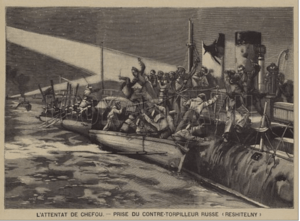Japanese destroyer Asashio (1902) facts for kids
Quick facts for kids History |
|
|---|---|
| Name | Asashio |
| Namesake | 朝潮 ("Morning Tide") |
| Ordered | 1900 |
| Builder | John I. Thornycroft & Company, Chiswick, England |
| Yard number | Destroyer No. 16 |
| Laid down | 3 April 1901 |
| Launched | 10 January 1902 |
| Completed | 4 May 1902 |
| Commissioned | 4 May 1902 |
| Reclassified |
|
| Stricken | 1 April 1923 |
| Fate |
|
| General characteristics | |
| Type | Destroyer |
| Displacement | 322 tons normal, 432 tons full load |
| Length |
|
| Beam | 20 ft 9 in (6.32 m) |
| Draught | 8 ft 3 in (2.51 m) |
| Depth | 13 ft 9 in (4.19 m) |
| Propulsion | 2-shaft reciprocating engines, 4 boilers, engine output 7,000 hp (5,200 kW) |
| Speed | 31 knots (57 km/h; 36 mph) |
| Complement | 62 |
| Armament |
|
| Service record | |
| Operations: |
|
The Asashio (meaning "Morning Tide") was a type of Japanese warship called a destroyer. Built in England in the early 1900s, she was one of two ships in her class, known as the Shirakumo-class destroyers. She played an important role in two major conflicts: the Russo-Japanese War (1904–1905) and World War I (1914–1918). During these wars, Asashio took part in several big naval battles, showing her strength and speed.
Contents
Building the Asashio
The Asashio was ordered in 1900 as "Destroyer No. 16." She was built by John I. Thornycroft & Company in Chiswick, England. Her construction began on 3 April 1901. She was officially launched on 10 January 1902 and given the name Asashio. The ship was finished and officially joined the Imperial Japanese Navy on 4 May 1902.
Asashio's Journey and Service
Asashio left England on 7 July 1902 to sail all the way to Japan. She arrived at Yokosuka on 20 November 1902, completing her long delivery trip.
Russo-Japanese War Battles
When the Russo-Japanese War began on 8 February 1904, Asashio was part of the 1st Destroyer Division. This war started with a surprise attack by Japan on Russian warships at Port Arthur, China.
Battle of Port Arthur
On the evening of 8 February 1904, ten Japanese destroyers, including Asashio, launched a torpedo attack. They got close to the Russian ships and fired their torpedoes. One torpedo hit the Russian cruiser Pallada.
Battle of the Yellow Sea
For several months, Japan kept a blockade around Port Arthur. On 10 August 1904, the Russian ships tried to escape to Vladivostok. Asashio took part in the Battle of the Yellow Sea that day. The Russians were defeated, and their commander was killed. After the battle, the Russian ships scattered.
The Reshitel‘nyi Incident
One Russian destroyer, the Reshitel‘nyi, tried to reach Chefoo, China, a neutral port, to send a message. Her crew was ordered to disarm the ship and have Chinese authorities keep it safe, following international rules for neutral countries.

Japan soon found out Reshitel‘nyi was in Chefoo. Asashio and another Japanese destroyer, Kasumi, entered the port. The Japanese tried to take control of Reshitel‘nyi. The Russian captain argued that his ship was being disarmed under international law. After a struggle, the Japanese took the Reshitel‘nyi as a prize. The Chinese authorities supported the Russian side, saying Japan had broken China's neutrality.
Battle of Tsushima
Asashio later joined the 4th Destroyer Division. She fought in the Battle of Tsushima on 27–28 May 1905. During this battle, Asashio and her division attacked the damaged Russian battleship Knyaz Suvorov with torpedoes. Although Asashio's torpedoes missed, another ship in her division scored a hit, and Knyaz Suvorov later sank.
World War I Service
On 28 August 1912, Asashio was reclassified as a third-class destroyer. When Japan joined World War I in August 1914, Asashio participated in the Battle of Tsingtao that same year.
Later Years and Fate
On 1 April 1922, Asashio was changed to a "special-duty vessel" and used as a second-class minesweeper. A year later, on 1 April 1923, she was removed from the navy's list and used as a target ship. She was turned into a hulk (a ship no longer fit for active service) on 2 May 1925 and finally sold on 5 April 1926.

